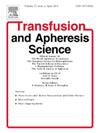Irradiation and beyond: Mitigating TA-GVHD in transfusion
IF 1.2
4区 医学
Q4 HEMATOLOGY
引用次数: 0
Abstract
Transfusion-associated graft-versus-host disease (TA-GVHD) is a rare but often fatal complication of allogeneic transfusion, caused by the activation and expansion of donor T lymphocytes in susceptible recipients. Prevention focuses on reducing these immune cells through leukoreduction and irradiation. While leukoreduction of blood components decreases white blood cell content and improves overall transfusion safety, it does not fully prevent TA-GVHD, as viable T cells may persist. Irradiation using gamma or X-ray methods remain the most effective strategy, inactivating donor T cells by inducing DNA damage and suppressing proliferation. However, it also compromises red blood cell quality by increasing hemolysis, oxidative injury, membrane damage, extracellular potassium, and reducing storage duration. As an alternative, hypothermic storage of leukoreduced red blood cells is gaining attention. Evidence suggests that extending storage beyond 21 days significantly reduces T cell viability and proliferation without compromising red blood cell integrity. Further research is needed to directly compare the efficacy of hypothermic storage to irradiation.
辐照及其他:减轻输血中的TA-GVHD
输血相关移植物抗宿主病(TA-GVHD)是一种罕见但往往致命的异基因输血并发症,由易感受体供体T淋巴细胞的激活和扩增引起。预防的重点是通过白细胞减少和照射减少这些免疫细胞。虽然血液成分的白细胞诱导降低了白细胞含量,提高了整体输血安全性,但它并不能完全预防TA-GVHD,因为活的T细胞可能会持续存在。使用伽马射线或x射线照射方法仍然是最有效的策略,通过诱导DNA损伤和抑制增殖来灭活供体T细胞。然而,它也通过增加溶血、氧化损伤、膜损伤、细胞外钾和缩短储存时间而损害红细胞质量。作为一种替代方法,白细胞诱导红细胞的低温储存正在引起人们的注意。有证据表明,储存超过21天会显著降低T细胞的活力和增殖,但不会损害红细胞的完整性。需要进一步的研究来直接比较低温储存和辐照的效果。
本文章由计算机程序翻译,如有差异,请以英文原文为准。
求助全文
约1分钟内获得全文
求助全文
来源期刊
CiteScore
3.60
自引率
5.30%
发文量
181
审稿时长
42 days
期刊介绍:
Transfusion and Apheresis Science brings comprehensive and up-to-date information to physicians and health care professionals involved in the rapidly changing fields of transfusion medicine, hemostasis and apheresis. The journal presents original articles relating to scientific and clinical studies in the areas of immunohematology, transfusion practice, bleeding and thrombotic disorders and both therapeutic and donor apheresis including hematopoietic stem cells. Topics covered include the collection and processing of blood, compatibility testing and guidelines for the use of blood products, as well as screening for and transmission of blood-borne diseases. All areas of apheresis - therapeutic and collection - are also addressed. We would like to specifically encourage allied health professionals in this area to submit manuscripts that relate to improved patient and donor care, technical aspects and educational issues.
Transfusion and Apheresis Science features a "Theme" section which includes, in each issue, a group of papers designed to review a specific topic of current importance in transfusion and hemostasis for the discussion of topical issues specific to apheresis and focuses on the operators'' viewpoint. Another section is "What''s Happening" which provides informal reporting of activities in the field. In addition, brief case reports and Letters to the Editor, as well as reviews of meetings and events of general interest, and a listing of recent patents make the journal a complete source of information for practitioners of transfusion, hemostasis and apheresis science. Immediate dissemination of important information is ensured by the commitment of Transfusion and Apheresis Science to rapid publication of both symposia and submitted papers.

 求助内容:
求助内容: 应助结果提醒方式:
应助结果提醒方式:


